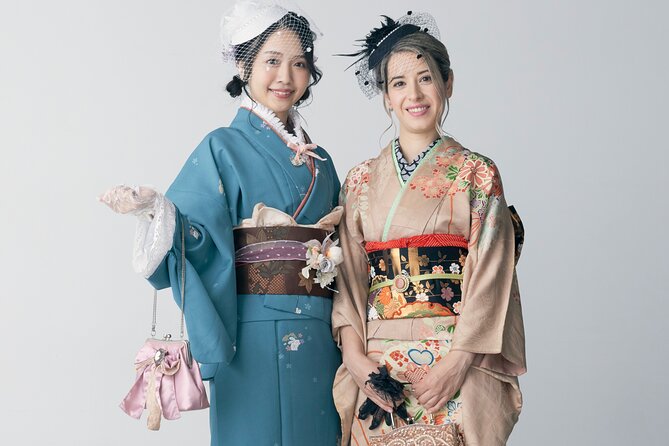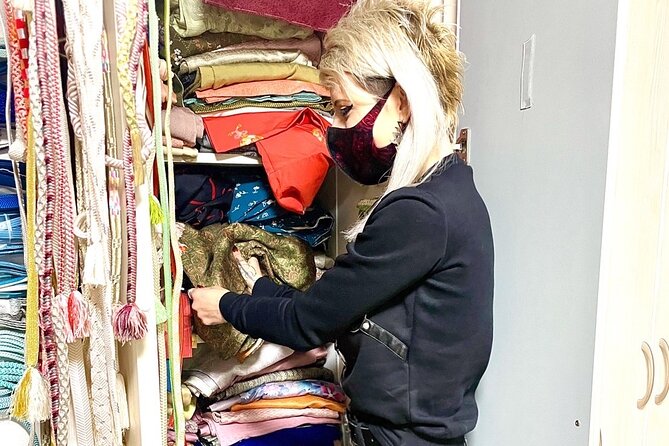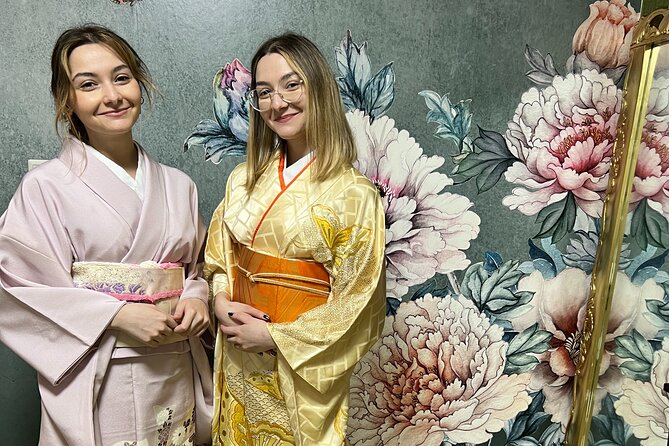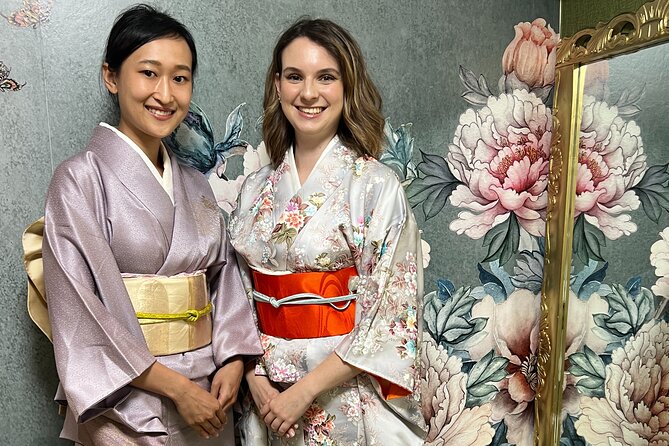Step into the world of tradition and creativity with ‘Let’s Make a Kimono! (Kimono Is a Gift for You),’ a hands-on experience where participants can enjoy the art of crafting a Japanese kimono.
Discover the secrets behind this iconic garment as you embark on a journey of fabric selection, intricate techniques, and personalized design.
Unleash your inner designer and create a piece that not only reflects Japanese culture but also holds the essence of a unique and unforgettable experience.
Just The Basics

- Kimono making involves intricate designs reflecting Japan’s heritage and art.
- Fabric choice impacts the elegance and draping of the kimono.
- Quality tools and precise techniques are essential for crafting a beautiful kimono.
- Customization options like embellishments and color choices add personal and cultural significance.
Here's some other great tours and experiences nearby we think you'll like.
History of the Kimono
The history of the kimono dates back centuries, showcasing a rich tradition of Japanese garment craftsmanship. Kimono fashion has been an integral part of Japanese culture, symbolizing the country’s heritage and traditions.
These iconic garments hold significant cultural significance, with each kimono design reflecting various aspects of Japanese art, nature, and society. From vibrant floral patterns to elegant geometric shapes, the kimono has evolved over time while still retaining its timeless appeal.
Today, the kimono continues to be worn on special occasions, ceremonies, and festivals, preserving its historical roots in modern society. Embracing a kimono signifies not only a fashion choice but also a connection to Japan’s rich cultural heritage.
Choosing the Right Fabric

When selecting fabric for a kimono, consider the texture and weight to ensure it drapes elegantly and complements the wearer’s figure. Fabric selection plays a crucial role in the overall look of the garment, with different materials offering various textures and draping qualities. Traditional kimono fabrics like silk and cotton hold cultural significance, but modern adaptations include synthetic blends for more affordable options. Color choices are also important, reflecting personal taste or occasion. Here is a simple guide to help you choose the right fabric for your kimono:
| Traditional Fabrics | Modern Fabrics |
|---|---|
| Silk | Synthetic blends |
| Cotton | Polyester |
| Linen | Rayon |
Consider these options to find the perfect fabric that suits your style and budget for your custom kimono creation.
Essential Tools and Supplies

For essential tools and supplies when making a kimono, consider gathering a sewing machine, sharp scissors, measuring tape, and quality thread. These tools are crucial for creating intricate kimono designs that align with current fashion trends.
In kimono workshops, participants often learn about the cultural significance of each step in the creation process. By investing in these basic supplies, you can engage in the art of kimono-making and explore their creativity.
Quality tools ensure precision and durability in the finished product, making them a worthwhile investment for those interested in this traditional craft. With the right equipment, enthusiasts can embark on their kimono-making journey with confidence and enthusiasm.
Cutting and Sewing Techniques
To master cutting and sewing techniques for creating a kimono, aspiring artisans should focus on precision and attention to detail. When designing a kimono, it’s crucial to understand its cultural significance and the traditional elements that make it unique.
Start by selecting high-quality fabric that complements the intended design. Carefully measure and cut the fabric according to the chosen kimono style, ensuring clean lines and symmetry. Sew each piece together with meticulous stitches to achieve a seamless look.
Remember that the beauty of a kimono lies in its simplicity and elegance, so avoid unnecessary embellishments. By honing these cutting and sewing skills, artisans can create stunning kimonos that honor tradition while showcasing their craftsmanship.
Adding Traditional Embellishments

Traditional embellishments play a vital role in enhancing the beauty and cultural significance of a kimono, adding intricate details that elevate its overall design. When it comes to embellishing a kimono, various techniques are used to customize and adorn the garment, reflecting both tradition and modern adaptations. Here’s a table summarizing some common embellishment techniques and customization options:
| Embellishment Techniques | Cultural Significance | Customization Options |
|---|---|---|
| Embroidery | Symbolism and heritage | Color choices |
| Shibori dyeing | Traditional craftsmanship | Pattern selection |
| Obi belts | Formality and style | Material variations |
These embellishments not only add beauty but also carry deep cultural meanings, allowing for personal touches while honoring tradition.
Fitting and Adjustments
When adjusting a kimono for a perfect fit, consider the wearer’s measurements and the garment’s traditional silhouette. Kimono sizing may vary, so alterations might be necessary to achieve the ideal look.
For custom kimono designs, tailoring services can make precise adjustments to ensure a comfortable and flattering fit. Tailors can skillfully modify the length of the sleeves, adjust the width of the garment, or alter the overall shape to match the wearer’s body type.
These alterations can enhance the elegance of the kimono while maintaining its cultural authenticity. By investing in tailored adjustments, you can enjoy the beauty of a well-fitted kimono that reflects their personal style and honors the garment’s traditional craftsmanship.
Styling Your Kimono
For a stylish twist on your kimono look, consider experimenting with different accessories to elevate your outfit effortlessly. Enhance the traditional kimono by incorporating modern elements like statement earrings or a sleek belt. Here are some budget-friendly kimono accessories and modernization ideas to help you make a fashion statement:
| Accessory | Description | Price |
|---|---|---|
| Obi belt | Adds definition to the waist | $15 |
| Tassel earrings | Gives a trendy touch | $10 |
| Platform sandals | Modernizes the look | $20 |
| Silk scarf | Adds a pop of color | $12 |
| Statement clutch | Completes the outfit | $18 |
Care and Maintenance Tips
To keep your kimono looking its best, regular care and maintenance are essential.
When it comes to storage solutions, consider hanging your kimono on padded hangers to prevent wrinkles and maintain its shape.
Avoid direct sunlight and damp areas to prevent color fading and mold growth.
If your kimono needs repair, simple techniques like hand-sewing loose threads or patching small tears can help extend its lifespan.
For larger repairs, seek out professional kimono repair services to ensure the garment is properly restored.
Frequently Asked Questions
Can I Bring My Own Fabric to the Workshop?
Yes, participants can bring their fabric to the workshop for fabric selection. Design preferences can be accommodated. The workshop supplies tools and guidance. Participant guidelines suggest bringing enough fabric for the project. Enjoy creating a unique kimono!
Are Children Allowed to Participate in Making a Kimono?
Children are welcome to participate in making a kimono. Parental involvement enhances the experience. Educational benefits include culture. The activity is child-friendly, offering a hands-on cultural experience. It’s an opportunity for kids to engage creatively and learn.
Is There a Minimum Skill Level Required to Join the Workshop?
For the workshop participation, there is no minimum skill level required as it is beginner-friendly. Participants can expect to learn basic techniques and not advanced skills. The session accommodates all levels of expertise.
Can I Customize the Design of My Kimono?
Design options for personalization are available, offering creative freedom and customization. Participants can tailor their kimonos to reflect their style preferences. This workshop provides a unique experience where you can express their creativity through traditional garment making.
Are There Any Restrictions on the Size or Length of the Kimono I Can Make During the Workshop?
There are no restrictions on the size or length of the kimono you can make during the workshop. Participants have the freedom to create a kimono based on their preferences without limitations.
Final Words
To sum it up, ‘Let’s Make a Kimono! (Kimono Is a Gift for You)’ offers a budget-friendly and informative cultural experience where travelers can learn about the history and craftsmanship of traditional Japanese kimono-making.
From selecting fabrics to mastering sewing techniques, you will walk away with a personalized souvenir that embodies the essence of Japanese culture.
Don’t miss this hands-on opportunity to learn about the world of Japanese textiles and craftsmanship.
